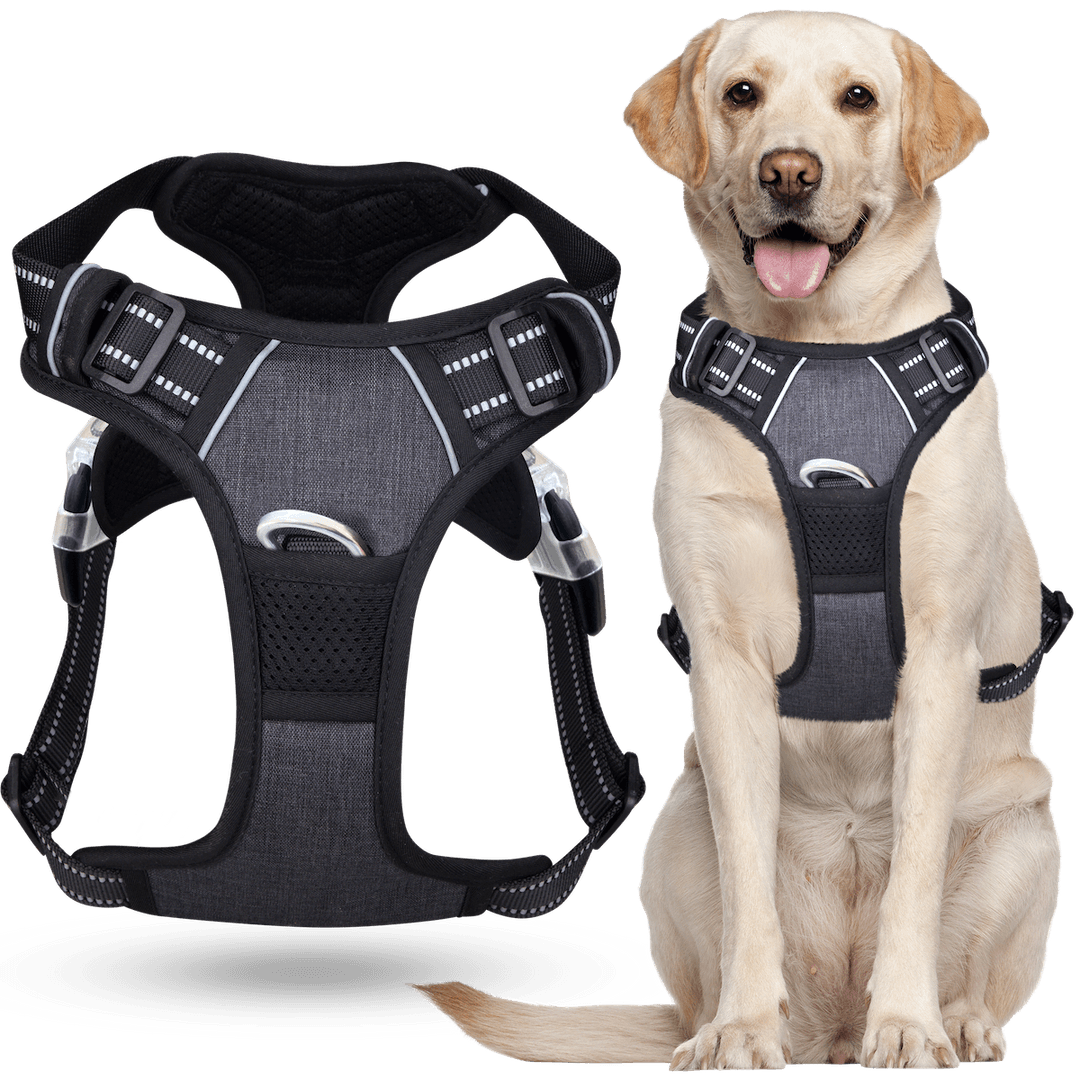
Muscle spasms in dogs can be distressing for pet owners, raising concerns about their canines’ well-being. Similar to humans, dogs can experience involuntary contractions of muscles, commonly known as spasms or cramps. These can range from mild twitches to more intense, prolonged spasms.
These movements make it seem like your dog is tweaking, with the affected parts assuming a life of their own. Witnessing muscle jerks in your beloved pet elicits a mix of concern and curiosity. The movements can result from over-exertion, electrolyte imbalances, dehydration, trauma, and more that we’ll discuss soon.
According to Dr. Sofie F. Bhatti and her co-authors[1], spasms in the muscles are often accompanied by stiffness. Learn this and more as we demystify sudden dog movements to be able to recognize the symptoms of muscle spams in dogs and seek appropriate treatment.
Table of Contents
- So, What Are Muscle Spasms in Dogs?
- Common Causes of Dog Muscle Spasms
- Symptoms of Muscle Spasms in Dogs
- Identifying a Spasm versus Tremors vs Twitching or Fasciculation
- Diagnosing Muscle Spasms in Dogs
- Treatment Options for Muscle Spasms in Dogs
- Prevention of Muscle Spasms
- When to Consult a Vet
- Frequently Asked Questions (FAQs)
- Final Thoughts
- References
So, What Are Muscle Spasms in Dogs?
Muscle spasms (myoclonus) in dogs are involuntary and sudden muscle contractions that can cause discomfort or pain. In some cases, the jerks may be the result of injury or overexertion. They also may be a symptom of a medical condition such as toxins, hyperparathyroidism, hypocalcemia, low blood sugar or neurological disorders.
Common symptoms include stiffness, trembling, and difficulty walking or standing.
In my work as a dog trainer, I have mostly seen muscle spasms after a dog swallowed poison, causing a kind of seizure and from extreme exercise. I have also seen many working breeds work to the point of dehydration and near-collapse, and this extreme exercise can disrupt the electrolytes in their body so much, it causes cramping muscles.
This is quite rare, but it emphasizes how important it is to monitor your exercising dogs and make sure that they rest, because active dogs will often exercise and work to the point that it becomes physically dangerous for them, and muscle cramps and spasms are honestly only one of the risks in these cases.
There are two main types of muscle cramps that doctors talk about in humans: “silent” cramps and “true” muscle cramps. Silent cramps might happen after a lot of exercise and can be linked to problems with how the body uses energy during exercise. True muscle cramps occur when the nerves that tell the muscles to move get too excited and make the muscles cramp up.
In dogs, muscle tics or cramps might be a bit different from what humans experience. A study on clinical features of muscle cramps in 14 dogs[2] found that prompting the dogs to move often caused these cramps. Additionally, these muscle movements are painful, with 58% of the cases presenting extreme pain.
If you suspect your dog is experiencing sudden muscle movements, it’s essential to consult a vet to determine the underlying cause and appropriate treatment. Our article on dogs kicking their back leg randomly will help if these contractions are specific to your dog’s hind limbs.
Common Causes of Dog Muscle Spasms

Muscle jolts can occur in dogs for a variety of reasons. Here are some of the most common causes:
1. Neurological Issues and Seizures
Neurological issues, such as spinal cord injuries or brain tumors, can cause muscle jolts in dogs. These disorders involve abnormalities in the brain, spinal cord, or peripheral nerves, disrupting the normal communication between the central nervous system and the muscles.
Seizures, caused by abnormal electrical activity in the brain, are a common neurological disorder that can also lead to sudden contractions. Our article on how to tell if my dog has seizures can help you spot them. Because contrary to popular belief, some seizures are more subtle than you may think.
If you suspect your dog has seizures, it’s essential to seek veterinary care immediately.
2. Dehydration
Dehydration can cause muscle jerks in dogs, especially when exercising in hot weather. Ensure they have access to plenty of fresh water at all times to help your dog cool down. Also, avoid exercising your pup during the hottest parts of the day.
Muscles rely on adequate hydration for proper contraction and relaxation. When a dog is dehydrated, the reduced fluid levels can affect the electrolyte balance in the body. Electrolytes, such as sodium, potassium, and calcium, play a crucial role in muscle function. Insufficient levels of these electrolytes can lead to muscle tics or cramps.
Interestingly, a PMC study[3] observed that water intake immediately after brief dehydration increased susceptibility to muscle cramps by diluting electrolytes. However, this effect is minor compared to spasms and happens as the muscles recover.
3. Overexertion
Overexertion can also lead to muscle spams in dogs. If your dog plays or exercises too hard, they may experience muscle fatigue and cramping. Make sure to give your dog plenty of breaks during exercise, and don’t push them beyond their limits.
4. Hypocalcemia and primary hypoparathyroidism
Just like people need calcium for strong bones, dogs need it for healthy muscles. When they don’t have enough, their muscles might start cramping. Hypocalcemia, characterized by low calcium levels in the blood, can be a significant cause of muscle jerks.
One primary cause of hypocalcemia is primary hypoparathyroidism[4], a disorder that occurs when the parathyroid glands fail to produce sufficient parathyroid hormone (PTH). Insufficient PTH causes blood calcium levels to fall and phosphorus to rise, causing muscles to contract and cramp.
5. Reactions to Toxins and Some Medications
Toxins can cause muscle contractions in dogs. It’s pretty easy to tell if a dog has been poisoned because they’ll have signs like foaming at the mouth, seizures, collapsing, vomiting, and diarrhea.
Keep your home free of toxic substances, and be mindful of what your dog is exposed to when you’re out and about. If your dog is on any medications, be sure to monitor them closely for any adverse reactions.
6. Low Blood Sugar (Hypoglycemia)
Low blood sugar can also cause body jerks, especially if they have diabetes or are a toy or teacup breed. Make sure your dog is on a consistent feeding schedule, and talk to your veterinarian about any dietary changes that may be necessary.
7. Trauma, Injuries & Nerve Damage
Trauma can result from accidents, falls, collisions, or any incident that causes damage to the dog’s muscles, bones, or nerves. The body’s reflexive response to injury is to contract muscles to stabilize the affected area and prevent further damage. This protective contraction can manifest as tics or cramps.

Stop Your Dog Pulling On Their Leash
Front and back clip points help redirect pulling so you get immediate, gentler control and can actually enjoy the walk again.
Shop Now 👉Better Walk Guarantee • 90-Day PawSafe® Promise
8. Nutritional Imbalances & Belly Issues
Inadequate levels of minerals such as potassium, calcium, and magnesium can result in sudden muscle movements. Providing a balanced and nutritious diet is essential for overall canine health.
Sometimes, problems inside a dog’s belly, like with their intestines, can cause them to lose proteins and other vital minerals, leading to cramps.
9. Resting Cramps and Older Dogs
Some dogs get cramps even when they’re just chilling and not doing much at all. Sometimes, older dogs seem to get muscle cramps more than younger ones, but vets aren’t always sure why that happens.
10. Joint Issues
Arthritis or other joint problems may cause discomfort and muscle jerks. Maintain a healthy weight and consider joint supplements under veterinary guidance. Hip dysplasia and patellar luxation can also cause random movements in the body due to discomfort.
11. Infections
One notable example of an infection that presents as body jerks is the canine distemper virus, a highly contagious and often fatal disease that affects the respiratory, gastrointestinal, and nervous systems. Additionally, some tick-borne diseases, such as Lyme disease, can cause random tics due to inflammation and infection.
Symptoms of Muscle Spasms in Dogs

It is crucial to identify the symptoms of muscle jerks to provide the necessary treatment.
Physical Signs
- Stiffness: One of the most common physical signs of myoclonia in dogs is stiffness. Dogs may have difficulty moving or may appear to be walking with a stiff gait.
- Inability to move: In severe cases, dogs may experience muscle rigidity, making it difficult for them to move at all.
- Shaking: They may also experience tremors or shaking. In some cases, this can manifest as leg shaking issues specifically affecting the hind limbs.
- Tense feel: The muscles may feel tense to the touch.
Behavioral Changes
Dogs with this condition may also exhibit behavioral changes.
- Irritability: They may become more irritable or restless and resist touching or handling.
- Signs of pain: They may also experience pain or discomfort, which can cause them to whine or whimper. In some cases, dogs may also experience seizures.
- Lethargy.
- **Difficulty Rising or Lying Down: **Dogs with muscle issues may struggle to stand up or lie down comfortably due to the pain and stiffness associated with the condition.
If you notice any of these symptoms in your dog, it is crucial to seek veterinary care as soon as possible.
Identifying a Spasm versus Tremors vs Twitching or Fasciculation
Muscle spasms, tremors, and fasciculation are all types of involuntary muscle movements that can occur in dogs. While they may seem similar, it’s essential to be able to differentiate between them to determine the appropriate treatment.
A spasm is a sudden, involuntary contraction of a muscle or group of muscles. Various factors, including injury, dehydration, electrolyte imbalances, or nerve damage, can cause it. Spasms may cause the affected area to feel tight or stiff and can be painful for the dog.
Tremors, on the other hand, are rhythmic, involuntary movements of a body part. Tremors can affect one or more body parts and can be intermittent or continuous.
Fasciculation is a type of twitching that occurs in a specific muscle or group of muscles. It can be caused by nerve damage, muscle disorders, or electrolyte imbalances. Fasciculation may be visible as small, rippling movements under the skin. You can see an example of this in the video below.
Diagnosing Muscle Spasms in Dogs
If you suspect your dog is experiencing muscle cramps, it is crucial to seek veterinary care immediately. Here’s how the vets will know what’s behind your pup’s sudden contractions:
Veterinary Examination
During a veterinary examination, your veterinarian will perform a physical examination of your dog to assess the severity of the muscle movements and to determine if there are any underlying causes. They may also ask you questions about your dog’s medical history, diet, and exercise routine to help diagnose the issue.

Make Every Walk Feel Under Control
Adjustable comfort design helps reduce leash tension fast so walks become calm, consistent, and more enjoyable for both of you.
Shop Now 👉Better Walk Guarantee • 90-Day PawSafe® Promise
Diagnostic Tests
To further diagnose the cause, your veterinarian may recommend diagnostic tests such as blood work, urinalysis, or imaging tests like X-rays or ultrasounds. These tests can help identify any underlying medical conditions that may be causing the muscle jerks.
In some cases, your veterinarian may also recommend a neurological examination to assess nerve function and rule out any issues with the nervous system.
Treatment Options for Muscle Spasms in Dogs
When it comes to treating sudden muscle movements in dogs, several options are available. The treatment approach will depend on the underlying cause of the spasms and the severity of the condition. For dogs needing mobility support during recovery, supportive harness options can help maintain stability. Here are some of the most common treatment options for muscle contractions in dogs:
Medication
Medication can be used to help relieve muscle tics in dogs. Some common medications that may be prescribed include muscle relaxants and anti-inflammatory drugs. Muscle relaxants can help reduce muscle tension, while anti-inflammatory drugs can help reduce inflammation and pain.
Physical Therapy
Physical therapy can also be used to help treat this condition. This may include exercises to help improve range of motion and strengthen muscles. Massage therapy and heat therapy may also be used to help reduce muscle tension and improve circulation.
Surgery
In some cases, surgery may be necessary to treat sudden muscle tics. This may be recommended if there is an underlying condition that is causing the spasms, such as a herniated disc or spinal cord injury. Surgery may also be recommended if other treatment methods have been unsuccessful.
Prevention of Muscle Spasms
Hydration
One crucial factor in preventing these convulsions is proper hydration. Dehydration can lead to muscle cramps and spasms, so make sure your dog always has access to clean, fresh water. If you’re going on a long walk or hike with your dog, bring along a portable water bowl and take frequent water breaks.
Regular exercise
Frequent working out is also vital for preventing this condition. Lack of physical activity can lead to muscle weakness and stiffness, increasing the likelihood of spasms. Make sure your dog gets plenty of exercise each day, whether that’s through walks, runs, or playtime in the backyard.
Balanced diet
Another way to prevent muscle convulsions is by providing your dog with a balanced diet that includes all the necessary nutrients. A diet deficient in certain vitamins and minerals, like calcium, can lead to muscle cramps and spasms. Talk to your veterinarian about the best diet for your dog’s specific needs.
Rest
Finally, make sure your dog gets plenty of rest. Overexertion can lead to muscle fatigue and spasms. Provide your dog with a comfortable place to rest and ensure they get enough sleep each night.

Enjoy Calm Walks Starting Today
Dual-attachment harness distributes pressure and helps turn tug-of-war outings into relaxed, bonding strolls from the first use.
Shop Now 👉Better Walk Guarantee • 90-Day PawSafe® Promise
When to Consult a Vet
If your dog experiences frequent or severe muscle spasms, it’s essential to consult a veterinarian. While some are harmless, others can be a symptom of a more serious underlying condition. Here are some signs that you should seek veterinary care:
- Your dog’s sudden movements are becoming more frequent or severe;
- Your dog is experiencing other symptoms, such as weakness, lethargy, or loss of appetite;
- Your dog is having trouble walking or standing; and
- Your dog’s muscle jerks are interfering with their daily activities or quality of life.
Frequently Asked Questions (FAQs)
Why is my dog twitching all of a sudden?
Muscle twitching in dogs can be caused by various factors, including stress, anxiety, dehydration, or muscle fatigue. Sometimes, it may be a symptom of an underlying medical condition. If your dog is experiencing sudden muscle twitching, it is best to consult a veterinarian to determine the cause.
What can cause muscle spasms in dogs?
Various factors, including injury, overexertion, dehydration, electrolyte imbalances, or underlying medical conditions such as arthritis or neurological disorders, can cause sudden muscle spasms in dogs. In some cases, these tics may be a symptom of a more severe condition, so it is essential to seek veterinary care if your dog is experiencing frequent or severe jerks.
When should I worry about muscle twitching in dogs?
If your dog is experiencing frequent or severe muscle twitching or if it is accompanied by other symptoms such as weakness, lethargy, or loss of appetite, it is crucial to seek veterinary care. Muscle twitching can be a symptom of a medical condition that requires treatment, so a veterinarian must evaluate your dog.
What do vets give dogs for muscle spasms?
The treatment for muscle jerks in dogs depends on the underlying cause. In some cases, rest and supportive care may be sufficient, while in other cases, medication may be necessary to alleviate pain and inflammation. Your veterinarian can recommend the appropriate treatment based on your dog’s specific needs after assessment.
What is involuntary muscle contraction in dogs?
Involuntary muscle spasms in dogs, also known as muscle spasms, occurs when the muscles contract and relax involuntarily. This can be caused by various factors, including injury, overexertion, dehydration, or underlying medical conditions. If your dog is experiencing involuntary muscle spasms, seek veterinary help.
How can I help my dog with muscle spasms?
If your dog is experiencing muscle movements, there are several things you can do to help alleviate their discomfort. Rest and supportive care, such as gentle massage and warm compresses, can help to relax the muscles and reduce pain and inflammation. Additionally, ensuring your dog is well-hydrated and has a balanced diet can help prevent this from occurring in the first place.
Final Thoughts
While spasms can be concerning for pet owners, it is essential to remember that they are often treatable and can be managed with proper care. If you suspect your dog is experiencing muscle jerks, seeking veterinary care as soon as possible is essential. Your veterinarian can help diagnose the underlying cause of the issue and develop a treatment plan to help your dog feel better.
In addition to veterinary care, there are also steps that you can take at home to help manage your dog’s sudden movements. These may include providing a comfortable and supportive environment for your dog, using heat or cold therapy, and providing gentle exercise to help improve muscle strength and flexibility.
References
- Myokymia and neuromyotonia in 37 Jack Russell terriers. ScienceDirect. https://www.sciencedirect.com/science/article/abs/pii/S1090023310002510
- Clinical features of muscle cramp in 14 dogs. PMC. https://www.ncbi.nlm.nih.gov/pmc/articles/PMC7848340/
- Water intake after dehydration makes muscles more susceptible to cramp but electrolytes reverse t.... PMC. https://www.ncbi.nlm.nih.gov/pmc/articles/PMC6407543/
- Hypoparathyroidism in Dogs - Musculoskeletal System. MSD Veterinary Manual. https://www.msdvetmanual.com/musculoskeletal-system/dystrophies-associated-with-calcium,-phosphorus,-and-vitamin-d/hypoparathyroidism-in-dogs#:~:text=Hypoparathyroidism+of+various+causes+is,increased+neuromuscular+excitability+and+restlessness.







